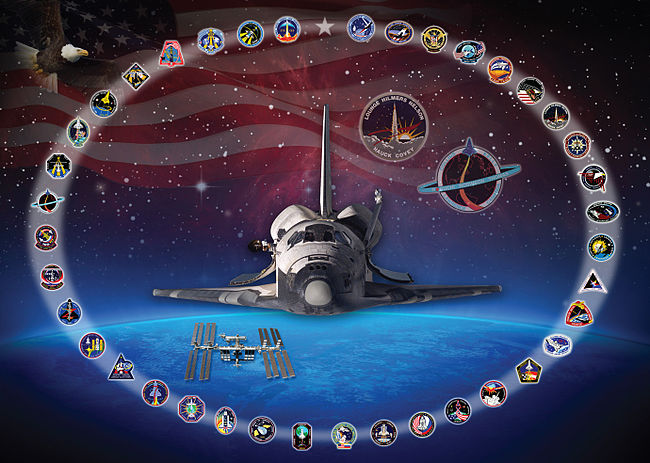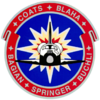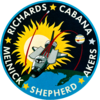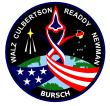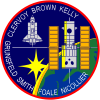
A | B | C | D | E | F | G | H | CH | I | J | K | L | M | N | O | P | Q | R | S | T | U | V | W | X | Y | Z | 0 | 1 | 2 | 3 | 4 | 5 | 6 | 7 | 8 | 9
| Discovery | |
|---|---|
 Discovery in orbit in 2011, during STS-133, the orbiter's final flight | |
| Type | Spaceplane |
| Class | Space Shuttle orbiter |
| Eponym | |
| Serial no. | OV-103 |
| Owner | NASA |
| Manufacturer | Rockwell International |
| Specifications | |
| Dry mass | 78,000 kilograms (172,000 lb) |
| Rocket | Space Shuttle |
| History | |
| First flight |
|
| Last flight |
|
| Flights | 39 |
| Flight time | 8,783 hours |
| Travelled | 238,539,663 kilometres (148,221,675 mi) around Earth[1] |
| Orbits | 5,830 around Earth |
| Fate | Retired |
| Location |
|
| Space Shuttle orbiters | |
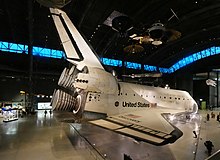

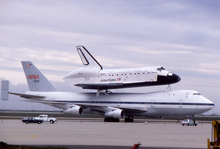
Space Shuttle Discovery (Orbiter Vehicle Designation: OV-103) is a retired American spacecraft. The spaceplane was one of the orbiters from NASA's Space Shuttle program and the third of five fully operational orbiters to be built.[2] Its first mission, STS-41-D, flew from August 30 to September 5, 1984. Over 27 years of service it launched and landed 39 times, aggregating more spaceflights than any other spacecraft to date. The Space Shuttle launch vehicle had three main components: the Space Shuttle orbiter, a single-use central fuel tank, and two reusable solid rocket boosters. Nearly 25,000 heat-resistant tiles cover the orbiter to protect it from high temperatures on re-entry.[3]
Discovery became the third operational orbiter to enter service, preceded by Columbia and Challenger.[4] It embarked on its final mission, STS-133, on February 24, 2011, and touched down for the last time at Kennedy Space Center on March 9,[5] having spent a cumulative total of nearly a full year in space. Discovery performed both research and International Space Station (ISS) assembly missions, and also carried the Hubble Space Telescope into orbit among other satellites.
Discovery was the first operational shuttle to be retired, followed by Endeavour and then Atlantis. The shuttle is now on display at the Steven F. Udvar-Hazy Center of the Smithsonian National Air and Space Museum.
History
The name Discovery was chosen to carry on a tradition based on ships of exploration,[2] primarily HMS Discovery,[6] one of the ships commanded by Captain James Cook during his third and final major voyage from 1776 to 1779, and Henry Hudson's Discovery,[2] which was used in 1610–1611 to explore Hudson Bay and search for a Northwest Passage. Other ships bearing the name have included HMS Discovery[7] of the 1875–1876 British Arctic Expedition to the North Pole, and RRS Discovery, which carried the 1901–1904 Discovery Expedition to Antarctica, led by Captain Scott.[8]
Space Shuttle Discovery launched the Hubble Space Telescope and conducted the second and third Hubble service missions. It also launched the Ulysses probe and three TDRS satellites. Twice Discovery was chosen as the "Return To Flight" Orbiter, first in 1988 after the loss of Challenger in 1986, and then again for the twin "Return To Flight" missions in July 2005 and July 2006 after the Columbia disaster in 2003. Project Mercury astronaut John Glenn, who was 77 at the time, flew with Discovery on STS-95 in 1998, making him the oldest person to go into space at that time in history.[9]
Had plans to launch United States Department of Defense payloads from Vandenberg Air Force Base gone ahead, Discovery would have become the dedicated US Air Force shuttle.[10] Its first West Coast mission, STS-62-A, was scheduled for 1986, but canceled in the aftermath of the Challenger disaster.
Discovery was retired after completing its final mission, STS-133 on March 9, 2011. The spacecraft is now on display in Virginia at the Steven F. Udvar-Hazy Center, an annex of the Smithsonian Institution's National Air and Space Museum.[11]
Construction milestones
| Date | Milestone[8] |
|---|---|
| 1979 January 29 | Contract Award to Rockwell International's Space Transportation Systems Division in Downey, California |
| 1979 August 27 | Start long lead fabrication of Crew Module |
| 1980 June 20 | Start fabrication lower fuselage |
| 1980 November 10 | Start structural assembly of aft-fuselage |
| 1980 December 8 | Start initial system installation aft fuselage |
| 1981 March 2 | Start fabrication/assembly of payload bay doors |
| 1981 October 26 | Start initial system installation, crew module, Downey |
| 1982 January 4 | Start initial system installation upper forward fuselage |
| 1982 March 16 | Midfuselage on dock, Palmdale, California |
| 1982 March 30 | Elevons on dock, Palmdale |
| 1982 April 30 | Wings arrive at Palmdale from Grumman |
| 1982 April 30 | Lower forward fuselage on dock, Palmdale |
| 1982 July 16 | Upper forward fuselage on dock, Palmdale |
| 1982 August 5 | Vertical stabilizer on dock, Palmdale |
| 1982 September 3 | Start of Final Assembly |
| 1982 October 15 | Body flap on dock, Palmdale |
| 1983 January 11 | Aft fuselage on dock, Palmdale |
| 1983 February 25 | Complete final assembly and closeout installation, Palmdale |
| 1983 February 28 | Start initial subsystems test, power-on, Palmdale |
| 1983 May 13 | Complete initial subsystems testing |
| 1983 July 26 | Complete subsystems testing |
| 1983 August 12 | Completed Final Acceptance |
| 1983 October 16 | Rollout from Palmdale |
| 1983 November 5 | Overland transport from Palmdale to Edwards Air Force Base |
| 1983 November 9 | Delivery to Kennedy Space Center |
| 1984 June 2 | Flight Readiness Firing |
| 1984 August 30 | First Flight (STS-41-D) |
Features and upgrades

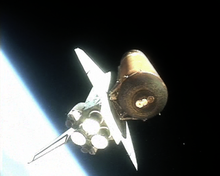


During its construction, Discovery was fitted with several black tiles near the middle starboard window where there should have been white tiles. It is unknown if this was the result of a harmless manufacturing mishap or done intentionally to give a distinctive look to the shuttle. This feature has been called 'teardrop' and allowed Discovery to be told apart from the rest of the fleet without looking at its name, although often unnoticed by the uninitiated.[12]
The spacecraft weighed roughly 6,870 lb (3,120 kg) less than Columbia when it was brought into service due to optimalizations determined during the construction and testing of Enterprise, Columbia and Challenger.[9] Discovery weighs 6 pounds (2.7 kg) heavier than Atlantis and 363 pounds (165 kg) heavier than Endeavour after further weight-saving adjustments were made.[13]
Part of the Discovery weight optimizations included the greater use of quilted AFRSI blankets rather than the white LRSI tiles on the fuselage, and the use of graphite epoxy instead of aluminum for the payload bay doors and some of the wing spars and beams.[14]
Upon its delivery to the Kennedy Space Center in 1983, Discovery was modified alongside Challenger to accommodate the liquid-fueled Centaur-G booster, which had been planned for use beginning in 1986 but was cancelled in the wake of the Challenger disaster.[15]
Beginning in late 1995, the orbiter underwent a nine-month Orbiter Maintenance Down Period (OMDP) in Palmdale, California. This included outfitting the vehicle with a 5th set of cryogenic tanks and an external airlock to support missions to the International Space Station. As with all the orbiters, it could be attached to the top of specialized aircraft and did so in June 1996 when it returned to the Kennedy Space Center, and later in April 2012 when sent to the Udvar-Hazy Center, riding piggy-back on a modified Boeing 747.[9]
After STS-105, Discovery became the first of the orbiter fleet to undergo Orbiter Major Modification (OMM) period at the Kennedy Space Center. Work began in September 2002 to prepare the vehicle for Return to Flight. The work included scheduled upgrades and additional safety modifications.[9]
Decommissioning
Discovery was decommissioned on March 9, 2011.[17][18] NASA offered Discovery to the Smithsonian Institution's National Air and Space Museum for public display and preservation, after a month-long decontamination process,[19] as part of the national collection.[20][21][22] Discovery replaced Enterprise in the Smithsonian's display at the Steven F. Udvar-Hazy Center in Virginia.[23][24][25] Discovery was transported to Washington Dulles International Airport on April 17, 2012, and was transferred to the Udvar-Hazy on April 19 where a welcome ceremony was held. Afterwards, at around 5:30 pm, Discovery was rolled to its "final wheels stop" in the Udvar Hazy Center.[26][27]
Flights

By its last mission, Discovery had flown 149 million miles (238 million km) in 39 missions, completed 5,830 orbits, and spent 365 days in orbit over 27 years.[28] Discovery flew more flights than any other Orbiter Shuttle, including four in 1985 alone. Discovery flew both "return to flight" missions after the Challenger and Columbia disasters: STS-26 in 1988, STS-114 in 2005, and STS-121 in 2006. Discovery flew the ante-penultimate mission of the Space Shuttle program, STS-133, having launched on February 24, 2011. Endeavour flew STS-134 and Atlantis performed STS-135, NASA's last Space Shuttle mission. On February 24, 2011, Space Shuttle Discovery launched from Kennedy Space Center's Launch Complex 39-A to begin its final orbital flight.[29]
Flights listing
| # | Date | Designation | Notes | Length of journey |
|---|---|---|---|---|
| 1 | August 30, 1984 | STS-41-D | First Discovery mission: Judith Resnik became second American woman in Space. Three communications satellites were put into orbit, including LEASAT F2. | 6 days, 00 hours, 56 minutes, 04 seconds |
| 2 | November 8, 1984 | STS-51-A | Launched two and rescued two communications satellites including LEASAT F1. | 7 days, 23 hours, 44 minutes, 56 seconds |
| 3 | January 24, 1985 | STS-51-C | Launched DOD Magnum ELINT satellite. | 3 days, 01 hours, 33 minutes, 23 seconds- |
| 4 | April 12, 1985 | STS-51-D | Launched two communications satellites including LEASAT F3. Carried first incumbent United States member of Congress into space, Senator Jake Garn (R–Utah) | 6 days, 23 hours, 55 minutes, 23 seconds |
| 5 | June 17, 1985 | STS-51-G | Launched two communications satellites, Sultan Salman al-Saud becomes first Saudi Arabian in space. | 7 days, 01 hours, 38 minutes, 52 seconds |
| 6 | August 27, 1985 | STS-51-I | Launched two communications satellites including LEASAT F4. Recovered, repaired, and redeployed LEASAT F3. | 7 days, 02 hours, 17 minutes, 42 seconds |
| 7 | September 29, 1988 | STS-26 | Return to flight after Space Shuttle Challenger disaster, launched TDRS-3. | 4 days, 01 hours, 00 minutes, 11 seconds |
| 8 | March 13, 1989 | STS-29 | Launched TDRS-4. | 4 days, 23 hours, 38 minutes, 52 seconds |
| 9 | November 22, 1989 | STS-33 | Launched DOD Magnum ELINT satellite. | 5 days, 00 hours, 06 minutes, 49 seconds |
| 10 | April 24, 1990 | STS-31 | Launch of Hubble Space Telescope (HST). | 5 days, 01 hours, 16 minutes, 06 seconds |
| 11 | October 6, 1990 | STS-41 | Launch of Ulysses. | 4 days, 02 hours, 10 minutes, 04 seconds |
| 12 | April 28, 1991 | STS-39 | Launched DOD Air Force Program-675 (AFP-675) satellite. | 8 days, 07 hours, 22 minutes, 23 seconds |
| 13 | September 12, 1991 | STS-48 | Upper Atmosphere Research Satellite (UARS). | 5 days, 08 hours, 27 minutes, 38 seconds |
| 14 | January 22, 1992 | STS-42 | International Microgravity Laboratory-1 (IML-1). | 8 days, 01 hours, 14 minutes, 44 seconds |
| 15 | December 2, 1992 | STS-53 | Department of Defense payload. | 7 days, 07 hours, 19 minutes, 47 seconds |
| 16 | April 8, 1993 | STS-56 | Atmospheric Laboratory (ATLAS-2). | 9 days, 06 hours, 08 minutes, 24 seconds |
| 17 | September 12, 1993 | STS-51 | Advanced Communications Technology Satellite (ACTS). | 9 days, 20 hours, 11 minutes, 11 seconds |
| 18 | February 3, 1994 | STS-60 | First Shuttle-Mir mission; Wake Shield Facility (WSF). First Russian launched in an American spacecraft (Sergei Krikalev). | 8 days, 07 hours, 09 minutes, 22 seconds |
| 19 | September 9, 1994 | STS-64 | LIDAR In-Space Technology Experiment (LITE). | 10 days, 22 hours, 49 minutes, 57 seconds |
| 20 | February 3, 1995 | STS-63 | Rendezvous with Mir space station. First female shuttle pilot Eileen Collins.[13] | 8 days, 06 hours, 29 minutes, 36 seconds |
| 21 | July 13, 1995 | STS-70 | Launched TDRS-7. | 8 days, 22 hours, 20 minutes, 05 seconds |
| 22 | February 11, 1997 | STS-82 | Servicing Hubble Space Telescope (HST) (HSM-2). | 9 days, 23 hours, 38 minutes, 09 seconds |
| 23 | August 7, 1997 | STS-85 | Cryogenic Infrared Spectrometers and Telescopes (CRISTA). | 11 days, 20 hours, 28 minutes, 07 seconds |
| 24 | June 2, 1998 | STS-91 | Final Shuttle/Mir Docking Mission. | 9 days, 19 hours, 55 minutes, 01 seconds |
| 25 | October 29, 1998 | STS-95 | SPACEHAB, second flight of John Glenn, who was 77 years of age at that time, the oldest man in space and third incumbent member of Congress to enter space. Pedro Duque became the first Spaniard in space. | 8 days, 21 hours, 44 minutes, 56 seconds |
| 26 | May 27, 1999 | STS-96 | First Space Shuttle mission to dock with the International Space Station[13] | 9 days, 19 hours, 13 minutes, 57 seconds |
| 27 | December 19, 1999 | STS-103 | Servicing Hubble Space Telescope (HST) (HSM-3A). | 7 days, 23 hours, 11 minutes, 34 seconds |
| 28 | October 11, 2000 | STS-92 | International Space Station Assembly Flight (carried and assembled the Z1 truss); 100th Shuttle mission. | 12 days, 21 hours, 43 minutes, 47 seconds |
| 29 | March 8, 2001 | STS-102 | International Space Station crew rotation flight (Expedition 1 and Expedition 2) | 12 days, 19 hours, 51 minutes, 57 seconds |
| 30 | August 10, 2001 | STS-105 | International Space Station crew and supplies delivery (Expedition 2 and Expedition 3) | 11 days 21 hours, 13 minutes, 52 seconds |
| 31 | July 26, 2005 | STS-114 | First "Return To Flight" mission since Space Shuttle Columbia disaster; International Space Station (ISS) supplies delivery, new safety procedures testing and evaluation, Multi-Purpose Logistics Module (MPLM) Raffaello. | 13 days, 21 hours, 33 minutes, 00 seconds |
| 32 | July 4, 2006 | STS-121 | Second "Return To Flight" mission since the Space Shuttle Columbia disaster, owing to concerns surrounding foam debris from the external tank during STS-114; International Space Station (ISS) supplies delivery, test new safety and repair techniques. | 12 days, 18 hours, 37 minutes, 54 seconds |
| 33 | December 9, 2006 | STS-116 | ISS crew rotation and assembly (carries and assembles the P5 truss segment); Last flight to launch on pad 39-B; First night launch since Space Shuttle Columbia disaster. |
12 days, 20 hours, 44 minutes, 16 seconds |
| 34 | October 23, 2007 | STS-120 | ISS crew rotation and assembly (carries and assembles the Harmony module). | 15 days, 02 hours, 23 minutes, 55 seconds |
| 35 | May 31, 2008 | STS-124 | ISS crew rotation and assembly (carries and assembles the Kibō JEM PM module). | 13 days, 18 hours, 13 minutes, 07 seconds |
| 36 | March 15, 2009 | STS-119 | International Space Station crew rotation and assembly of a fourth starboard truss segment (ITS S6) and a fourth set of solar arrays and batteries. Also replaced a failed unit for a system that converts urine to drinking water. |
12 days, 19 hours, 29 minutes, 33 seconds |
| 37 | August 28, 2009 | STS-128 | International Space Station crew rotation and ISS resupply using the Leonardo Multi-Purpose Logistics Module. Also carried the C.O.L.B.E.R.T treadmill named after Stephen Colbert | 13 days 20 hours, 54 minutes, 40 seconds |
| 38 | April 5, 2010 | STS-131 | ISS resupply using the Leonardo Multi-Purpose Logistics Module. The mission also marked the first time that four women were in space and the first time that two Japanese astronauts were together on a space station.[30] Longest mission for this Orbiter. | 15 days 2 hours, 47 minutes 11 seconds‡ |
| 39 | February 24, 2011 | STS-133 | The mission launched at 4:53 pm EST on February 24, was carrying the Permanent Multipurpose Module (PMM) Leonardo, the ELC-4 and Robonaut 2 to the ISS.[31] Final flight of Discovery. | 12 days 19 hours, 4 minutes, 50 seconds |
‡ Longest shuttle mission for Discovery
– shortest shuttle mission for Discovery
Mission and tribute insignias
